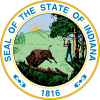
Presidential elections were held in the United States on November 3, 1908. Republican Party nominee William Howard Taft defeated threetime Democratic nominee William Jennings Bryan. Incumbent President Theodore Roosevelt honored his promise not to seek a third term, and persuaded his close friend, Taft, to become his successor. With Roosevelt's support, Taft won the presidential nomination at the 1908 Republican National Convention on the first ballot. The Democratic Party nominated Bryan, who had been defeated twice previously, in 1896 and 1900, by Republican William McKinley.
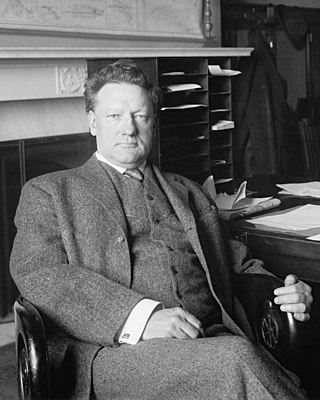
James Eli Watson was a U.S. Representative and U.S. Senator from Indiana. He was the Senate's second official majority leader. While an article published by the Senate gives his year of birth as 1862, this is most probably incorrect.

Thomas Taggart was an Irish-American politician who was the political boss of the Democratic Party in Indiana for the first quarter of the twentieth century and remained an influential political figure in local, state, and national politics until his death. Taggart was elected auditor of Marion County, Indiana (1886–1894), and mayor of Indianapolis. His mayoral administration supported public improvements, most notably the formation of the city's park and boulevard system. He also served as a member of the Democratic National Committee (1900–1916) and as its chairman (1904–1908). Taggart was appointed to the U.S. Senate in March 1916, but lost the seat in the November election.
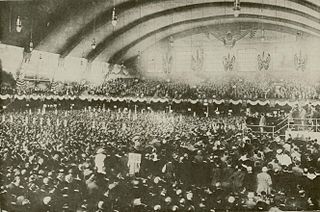
The 1912 Democratic National Convention was held at the Fifth Regiment Armory off North Howard Street in Baltimore from June 25 to July 2, 1912.

The 1916 United States presidential election in New York took place on November 7, 1916. All contemporary 48 states were part of the 1916 United States presidential election. Voters chose 45 electors to the Electoral College, which selected the president and vice president.

The 1916 United States presidential election in Massachusetts took place on November 7, 1916, as part of the 1916 United States presidential election, which was held throughout all contemporary 48 states. Voters chose 18 representatives, or electors to the Electoral College, who voted for president and vice president.

The 1912 United States presidential election in Massachusetts took place on November 5, 1912, as part of the 1912 United States presidential election, which was held throughout all contemporary 48 states. Voters chose 18 representatives, or electors to the Electoral College, who voted for president and vice president.

The 1912 United States presidential election in Vermont took place on November 5, 1912, as part of the 1912 United States presidential election which was held throughout all contemporary 48 states. Voters chose four representatives, or electors to the Electoral College, who voted for president and vice president.

The 1912 United States presidential election in New Jersey took place on November 5, 1912. All contemporary 48 states were part of the 1912 United States presidential election. Voters chose 14 electors to the Electoral College, which selected the president and vice president.

The 1916 United States Senate special election in Indiana took place on November 7, 1916 to complete the unexpired term of Benjamin F. Shively. Interim Democratic Senator Thomas Taggart was defeated in his bid to complete the term by U.S. Representative James Eli Watson.

From March 9 to June 5, 1920, voters of the Democratic Party elected delegates to the 1920 Democratic National Convention, for the purposing of choosing a nominee for president in the 1920 United States presidential election.
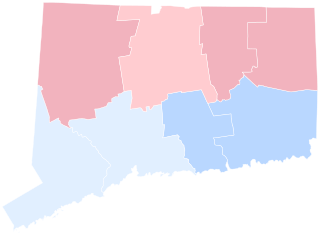
The 1912 United States presidential election in Connecticut took place on November 5, 1912, as part of the 1912 United States presidential election which was held throughout all contemporary 48 states. Voters chose seven representatives, or electors to the Electoral College, who voted for president and vice president.

The 1908 United States presidential election in Florida was held on November 3, 1908, as part of the 1908 United States presidential election. Voters chose five representatives, or electors to the Electoral College, who voted for president and vice-president. With the disenfranchisement of African-Americans by a poll tax in 1889, Florida become a one-party Democratic state, which it was to remain until the 1950s, apart from the anti-Catholic vote against Al Smith in 1928. Unlike southern states extending into the Appalachian Mountains or Ozarks, or Texas with its German settlements in the Edwards Plateau, Florida completely lacked upland or German refugee whites opposed to secession. Thus Florida's Republican Party between 1872 and 1888 was entirely dependent upon black votes, a fact is graphically seen when one considers that – although very few blacks in Florida had ever voted within the previous fifty-five years – at the time of the landmark court case of Smith v. Allwright, half of Florida's registered Republicans were still black. Thus disfranchisement of blacks and poor whites left Florida as devoid of Republican adherents as Louisiana, Mississippi, or South Carolina.
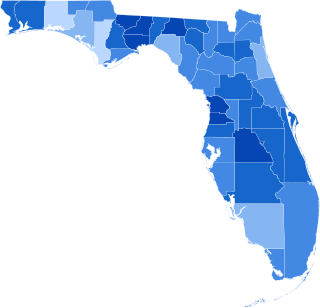
The 1904 United States presidential election in Florida was held on November 8, 1904. Voter chose five representatives, or electors to the Electoral College, who voted for President and Vice-president.
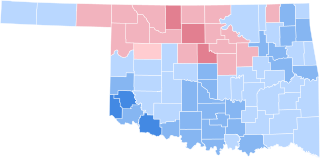
The 1912 United States presidential election in Oklahoma took place on November 5, 1912, as part of the 1912 United States presidential election. Voters chose ten representatives, or electors, to the Electoral College, who voted for president and vice president.

The 1912 United States presidential election in Illinois took place on November 5, 1912, as part of the 1912 United States presidential election. State voters chose 29 representatives, or electors, to the Electoral College, who voted for president and vice president.

The 1916 United States Senate election in New York was held on November 7, 1916. Incumbent Democratic Senator James O'Gorman chose not to seek re-election. Republican William M. Calder was elected to a succeed O'Gorman, defeating Democrat William F. McCombs.

The 1940 Indiana gubernatorial election was held on November 5, 1940. Democratic nominee Henry F. Schricker narrowly defeated Republican nominee Glenn R. Hillis with 49.92% of the vote.

The 1916 Indiana gubernatorial election was held on November 7, 1916. Republican nominee James P. Goodrich narrowly defeated Democratic nominee John A. M. Adair with 47.80% of the vote.

The 1896 Indiana gubernatorial election was held on November 3, 1896. Republican nominee James A. Mount defeated Democratic nominee Benjamin F. Shively with 50.93% of the vote.

